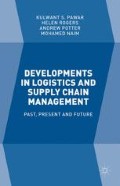Abstract
Increasing globalisation and lowering ocean freight help each nation focus on producing commodities of its specialty. With high quality but low paid labour, Asian nations have manufactured delicate industrial products and sold them to the EU and the US. North America has large arable lands that are suitable for planting agriculture (e.g., grains) with large farming machinery. The harvest grains can then be exported to the Asian nations. The major grains trade in the cross Pacific Ocean route could include soya bean, corn and wheat. The rapid increase of dry bulker freight between 2002 and 2008 forced the grain importers and shippers to ship their grain cargo by dry containers. It is estimated the containerisation ratio was around 80% in 2008. The grain containers could be used to control the freight cost for grain importers, and the grain cargoes can be transported on a door-to-door basis. It increases the importers’ competitiveness because of its door-to-door service ability, its low ocean freight and small parcel size, reducing grain silo storage time and avoiding high inventory cost occurred by lengthy in-transit time. In short, the total logistics cost of imported grain cargoes can be reduced by using the container shipping service. Historical data reveal that only around 50% of containers exported from Asia to North America can find backhaul cargoes because many empty containers were trapped in North America in the 1990s.
Access this chapter
Tax calculation will be finalised at checkout
Purchases are for personal use only
Preview
Unable to display preview. Download preview PDF.
References
Buckley, J. J. (1985) “Fuzzy Hierarchical Analysis”, Fuzzy Sets and Systems, 17, 233–247.
D’este, G. M. (1992) “Carrier selection in a RO/RO ferry trade Part 2: conceptual framework for the decision process”, Maritime policy and Management, 19(2), 127–138.
Evers, P. T, Harper, D. V. and Needham, P. M. (1996) “The determinants of shipper perceptions of modes”, Transportation Journal, 36(2), 13–25.
FAO (2007) “Most important agricultural imports and exports (in value terms)”, http://www.fao.org/statistics/yearbook/vol_1_1/pdf/c10.pdf (accessed on 28 September 2008).
Feng, J. M. and Chiu, Y. J. (2004) Research Methodology, Chiendu Press, Hsinju City.
Haugen, K. K. and Hervik, A. (2004) “A game theoretic ‘mode-choice’ model for freight transportation”, The Annals of Regional Science, 38(3), 469–484.
Lyons, M. (2000) “Diversify Your Wheat Markets: How to Establish Identity Preserved Channels Using Containers”, Wheat Markets in Asia, Washington Wheat Commission, Idaho Wheat Commission, and U.S. Department of Agriculture Conference presentation.
Meixell, M. J. and Norbis, M. (2008) “A review of the transportation mode choice and carrier selection literature”, The International Journal of Logistics Management, 19(2), 183–211.
Pedersen, E. L. and Gray, R. (1998) “The transport selection criteria of Norwegian exporters”, International Journal of Physical Distribution & Logistics Management, 28(2), 108–120.
Saaty, T. L. (1980) The Analytic Hierarchy Process-Planning, Priority Setting, Resource Allocation, McGraw-Hill, New York.
Shinghal, N. and Fowkes, T. (2002) “Freight mode choice and adaptive stated preferences”, Transportation Research, Part E, 38(5), 367–378.
Soon, B. N. (2005) “The Competitive Position of U.S. Corn and Soybean in Asian Markets: A Customer’s Perspective” Presentation at 2005 Commodity Classic, Austin, Texas, 26 February.
Train, K. and Wilson, W. W. (2007) “Spatially generated transportation demands”, Railroad Economics Research in Transportation Economics, 20, 97–118.
Tsaur, S. H., Tzeng, G. H. and Wang, K. C. (1997) “Evaluating tourist risks from fuzzy perspectives,” Annals of Tourism Research, 24(4), 796–813.
USDA (2007) Grain Transportation Report, 27 December 2007, http://www.ams.usda.gov/tmdtsb/grain/2007/12-27-07.pdf (accessed on 31 December 2007).
Vachal, K. and Reichert, H. (2001) “U.S. Containerised Grain and Oilseed Exports”, Industry Profile: Phase I. USDA.
Vannieuwenhuyse, B., Gelders, L. and Pintelon, L. (2003) “An online decision support system for transportation mode choice”, Logistics Information Management, 16(2), 125–133.
Zadeh, L. A. (1965) “Fuzzy sets”, Information and Control, 8, 338–353.
Zadeh, L. A. (1972) “A rationale for fuzzy control”, Journal of Dynamic Systems, Measurement and Control, 94(G), 3–4.
Zadeh, L. A. (2008) “Is there a need for fuzzy logic?” Information Sciences, 178(13), 2751–2779.231–239
Editor information
Editors and Affiliations
Copyright information
© 2016 Ted T. C. Lirn and Jung-De Wang
About this chapter
Cite this chapter
Lirn, T.T.C., Wang, JD. (2016). The Determinants of Containerised Grain Shipping. In: Pawar, K.S., Rogers, H., Potter, A., Naim, M. (eds) Developments in Logistics and Supply Chain Management. Palgrave Macmillan, London. https://doi.org/10.1057/9781137541253_19
Download citation
DOI: https://doi.org/10.1057/9781137541253_19
Publisher Name: Palgrave Macmillan, London
Print ISBN: 978-1-349-55848-3
Online ISBN: 978-1-137-54125-3
eBook Packages: Business and ManagementBusiness and Management (R0)

